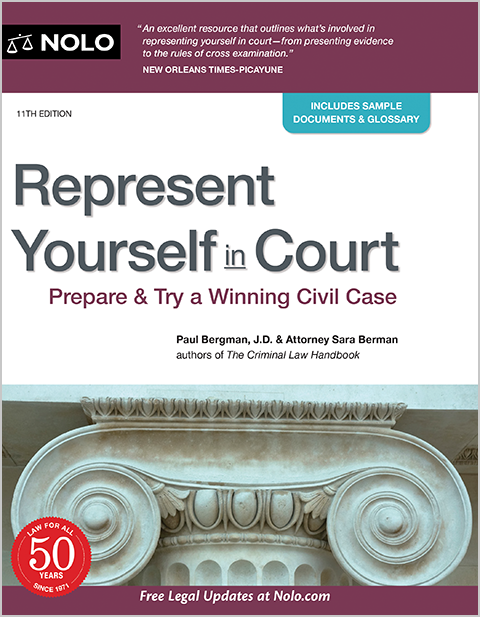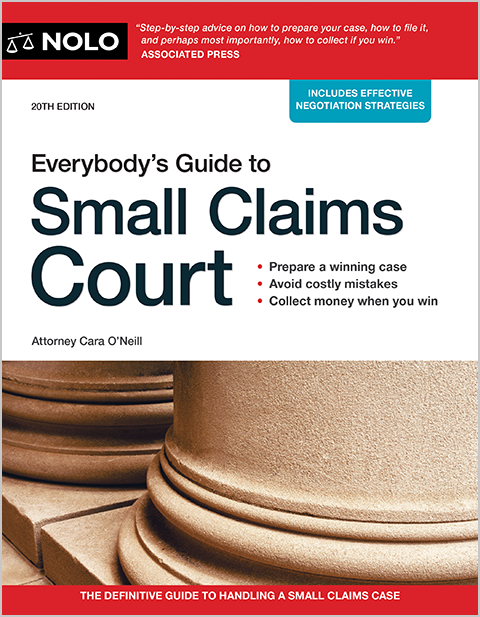Here are the three keys to figuring out how much time you have to file a lawsuit in court.
A statute of limitations is a law that puts a deadline on your time to file a lawsuit in court. Each state makes its own statutes of limitations, and it's common for a state to have different deadlines for different kinds of cases. If you're considering a lawsuit of any kind, one of the first—and most critical—questions should be: How long do I have before the statute of limitations runs out?
To answer that question, you need to know at least three things:
- how much time the statute gives you
- when the limitations clock begins to run, and
- whether the clock might pause for some time.
Why does this matter? Because if the statute expires before you sue, the court probably will dismiss your case. You've lost the right to collect compensation ("damages") for your injuries.
In this article, we walk you through the process of computing statute of limitations deadlines.
How Much Time Does the Statute Give You?
A statute of limitations will tell you how much time—usually in years—you have to file your lawsuit. So, for instance, you have two years to file a Florida wrongful death case. (Fla. Stat. § 95.11(5)(e) (2025).) In Georgia, there's a two year statute of limitations on most personal injury claims. (Ga. Code § 9-3-33 (2025).) Want to sue someone for damaging your property in Arkansas? You have three years. (Ark. Code § 16-56-105 (2025).)
There can be situations when it's hard to know what statute of limitations applies to your claim. Wrongful death cases are a frequent example. When two or more possible deadlines might apply, the safest course is to assume that the shortest limitation period controls. But don't take needless chances. If you're unsure about the deadline, get help from an attorney right away.
Here's a state-by-state chart showing the statutes of limitations for contract, personal injury, and property damage cases.
When Does the Clock Start to Run?
Once you know the limitation period, it's time to figure out when the clock starts running. Fair warning: While it might seem like this should be easy to do, things can get very complicated, very quickly at this step. When there's a fight over the statute of limitations, this is often what the fight is about. Many times, it comes down to a case-specific fact analysis.
The Three Most Common Starting Dates
These, from earliest to latest, are the three most common statute of limitations starting dates:
- the date you were injured
- the date you should have known you were injured, or
- the date you actually knew you were injured.
Each state gets to decide which of these dates will apply to different kinds of cases. And the controlling date can make a huge difference. Here's why.
The earlier the starting date, the more friendly it is to the defendant (the party being sued). Why? Because the sooner the clock starts, the sooner it stops. Relative to later dates, an earlier starting date effectively shortens the limitation period. For the opposite reason, the later the starting date, the more it favors the plaintiff (the party who's suing).
So, when a state wants to give a potential edge to plaintiffs, it will say the statute of limitations runs from the date the plaintiff knew or should have known they'd been hurt. These later dates give plaintiffs more time to learn about their injuries, especially those that don't appear right away.
Conversely, when a state wants to favor defendants, it will say that the clock starts ticking on the date of injury, regardless of when (or if) the plaintiff knew they'd been hurt. This earlier date puts the burden on the plaintiff to promptly investigate and learn the extent of potential injuries, even if they're not immediately apparent.
Let's have a closer look at how each of these dates works.
Date of Your Injury
The date you were injured is the date on which the events that harmed you took place. It's the date you were in a car wreck, in a personal injury or property damage case. For a breach of contract lawsuit, it's probably when the contract was violated. If you sue for a statutory violation, the date your opponent violated the statute is the date of your injury.
In an easy case—like our car accident example above—starting the clock on the date you were injured poses no problems. You know you've been hurt, you know who hurt you, and you know how it happened. In short, on the date you were injured, you have all the facts you need to file a lawsuit.
As we explain below, that won't always be true.
Date You Should Have Known You Were Injured
Unfortunately, some cases aren't as bright line as our hypothetical car accident suit. For example, say you have abdominal surgery. All seems well for about six months after the operation. But then you start to have worsening belly pain. Thinking the pain will just go away on its own, you ignore it for a couple of months. At that point, you see your doctor. An X-ray shows that the surgeon carelessly left a surgical sponge in your abdomen.
There's no way you could have known on the date of the surgery—the date of your injury—that you'd been harmed. For that reason, state law might say the statute of limitations started running when you began having abdominal pain six months post-surgery. That's the date, the argument would go, that you should have known you might have been hurt by the surgeon's wrongdoing.
In legal terms, you had "constructive notice" of your injury from that point forward. The burden shifts to you to investigate a potential legal claim.
Date You Actually Knew You Were Injured
Let's continue with our surgery example. The law might say that the statute doesn't start running until the date you actually knew you'd been injured, when an X-ray revealed the leftover sponge. This is called the "discovery rule." Some states apply it across the board, in all kinds of cases. Others limit it to certain kinds of claims or to specific facts. Don't assume the discovery rule applies—get confirmation that it does, in your particular type of case.
The discovery rule is the most lenient of all three starting date rules. Because the clock doesn't begin running until you actually know about an injury, you don't have to be quite as vigilant when this rule applies.
Special Rules for Installment Contracts
An installment contract is a written agreement that calls for payments over time, in regular, periodic installments. When an installment contract is involved, the statute of limitations normally applies separately to each installment as it becomes due.
For example, suppose Joan loaned Larry $5,000. Larry agreed, in writing, to pay back the loan in five installments of $1,000 plus interest, beginning on January 1, 2025, and continuing on January 1 of each year through 2029. The state has a five year statute of limitations on written contracts.
On January 1, 2025, Larry didn't pay the first installment. Joan has five years from that date to sue him for the past-due installment. If he defaults on the second installment due on January 1, 2026, Joan has until January 1, 2031 to file a lawsuit for that payment. The same rule applies to each annual installment as it comes due.
This rule doesn't apply if the contract includes an "acceleration clause," meaning language that says when one installment payment is missed, all remaining payments immediately become due. Had Joan included such a clause in her agreement with Larry, she could have collected the entire $5,000 (plus interest) in a lawsuit filed within five years of January 1, 2025.
When Might the Limitation Clock Pause?
In a handful of situations, the limitations clock stops running, or pauses. Judges and lawyers call this "tolling." Here too, states get to make their own rules. But most toll the statute when one or more of these conditions exists:
- the plaintiff was a minor (in most states, younger than 18) at the time they were injured
- the defendant goes into hiding or flees the state to escape a lawsuit
- the defendant is in prison, or
- a court finds the plaintiff to be mentally incompetent.
The statute tolls, or stops, usually for as long as the condition lasts. A couple of examples illustrate how tolling works.
Defendant Flees to Avoid Lawsuit
Jack borrowed money from Tim under a written promissory note. When the note came due, Jack failed to pay. Six months later, Jack got wind that Tim was getting ready to file a lawsuit to collect the past due amount. Jack immediately left the country to avoid being served with Tim's lawsuit papers.
Assume that the state has a five year statute of limitations on claims involving written contracts like this one. The statute ran for six months after Jack failed to pay and before he took off. But as soon as he fled, the statute paused. If Jack returns to the state two years later, Tim will have four-and-a-half years from the date of Jack's return to file his lawsuit in court.
Plaintiff Is a Minor
Ed, beginning at age 12, starred in a TV series for four years. The day before his 17th birthday, an accountant told Ed's family that Ed hadn't been paid all the money due under his contract. Assume the state has a four-year statute on written contracts. How long does Ed have to sue?
Because Ed was injured as a minor, the limitation period is tolled until his 18th birthday. As a result, Ed has four years from his 18th birthday—or until his 22nd birthday—to sue for the money he's owed.
Things That Look and Act Like Statutes of Limitations
To complicate things even more, you might face a couple of other deadlines that look and act like statutes of limitations, but are called something else. In particular, be on the lookout for:
- a claim notice requirement when you're making a claim against the government, and
- a statute of repose, which puts an outside limit on your time to file a case in court.
Claim Notice Requirements
Lots of special rules protect the government from lawsuits. Among them is the claim notice requirement. As the name suggests, this rule requires that you to give the government written notice when it injures you and you want to bring an injury (or other) claim. Notice requirements typically extend to the state and its counties, townships, and municipalities.
Note, importantly, that this notice is in addition to—not in lieu of—the statute of limitations. In other words, when you make a claim against the government, you first have to provide written notice of your claim. Then, if you later want to sue the government in court, you also have to do so before the statute of limitations expires.
Be prepared to act quickly. In some places, notice is due within 60 days from the date you're injured. State and local laws often specify the forms and procedures you must use to give notice. And more often than not, failure to timely provide notice as required by law means the government is off the hook—you can't recover for your injuries.
Learn more about claims against the government in your state.
The Statute of Repose
Suppose you encounter a statute of limitations that looks like this:
"An injured party shall have three years from the date they discover an injury to file a lawsuit. But in no event shall suit be filed more than five years from the date of the act or event causing the injury."
The first sentence is a three-year statute of limitations. The clock runs from the date you actually discover your injury. So far, so good.
What about the second sentence? While it looks like a statute of limitations, it's actually a statute of repose, meaning a rule that puts an outside deadline on your time for filing in court. Many statutes of repose are designed to cap the discovery rule, discussed above.
In our example, because there's a three-year statute of limitations, the statute of repose effectively limits the discovery period to two years from the date of injury. Without this five-year cap, the discovery rule could extend the limitation period indefinitely, defeating its purpose.
What If You Think the Statute of Limitations Has Run Out?
If you think the statute of limitations on your case has expired, your first call should be to an experienced lawyer. You have three questions, corresponding to those in our introduction:
- What's the statute of limitations on my claim?
- When did the limitation clock start running?
- If the statute has expired or is about to, is there any way to toll it?
Lawyers make their living by arguing the facts and the law. If there's a good-faith argument that you should have more time to file a lawsuit, your lawyer is apt to find it.
Now for the bad news. If the statute of limitations has passed and you can't extend it, you're out of luck. File a lawsuit and the court will have no choice but to dismiss it at the defendant's request. You've lost the right to collect damages for your losses.
Get Help With Your Statute of Limitations Problem
There are some legal problems you can tackle on your own. The statute of limitations isn't one of them. In fact, statute problems can be so complicated that most of lawyers who don't regularly file lawsuits won't touch a statute of limitations issue, for fear of a costly mistake.
Stated more directly, when you're up against the statute of limitations, you're in over your head. Opposing counsel know how to make quick work of unrepresented parties when thorny issues like these arise. And you won't get any help from the court, either.
Your best chance of success will come from having a seasoned legal veteran on your side. Don't delay, because time if the enemy of your claim.



